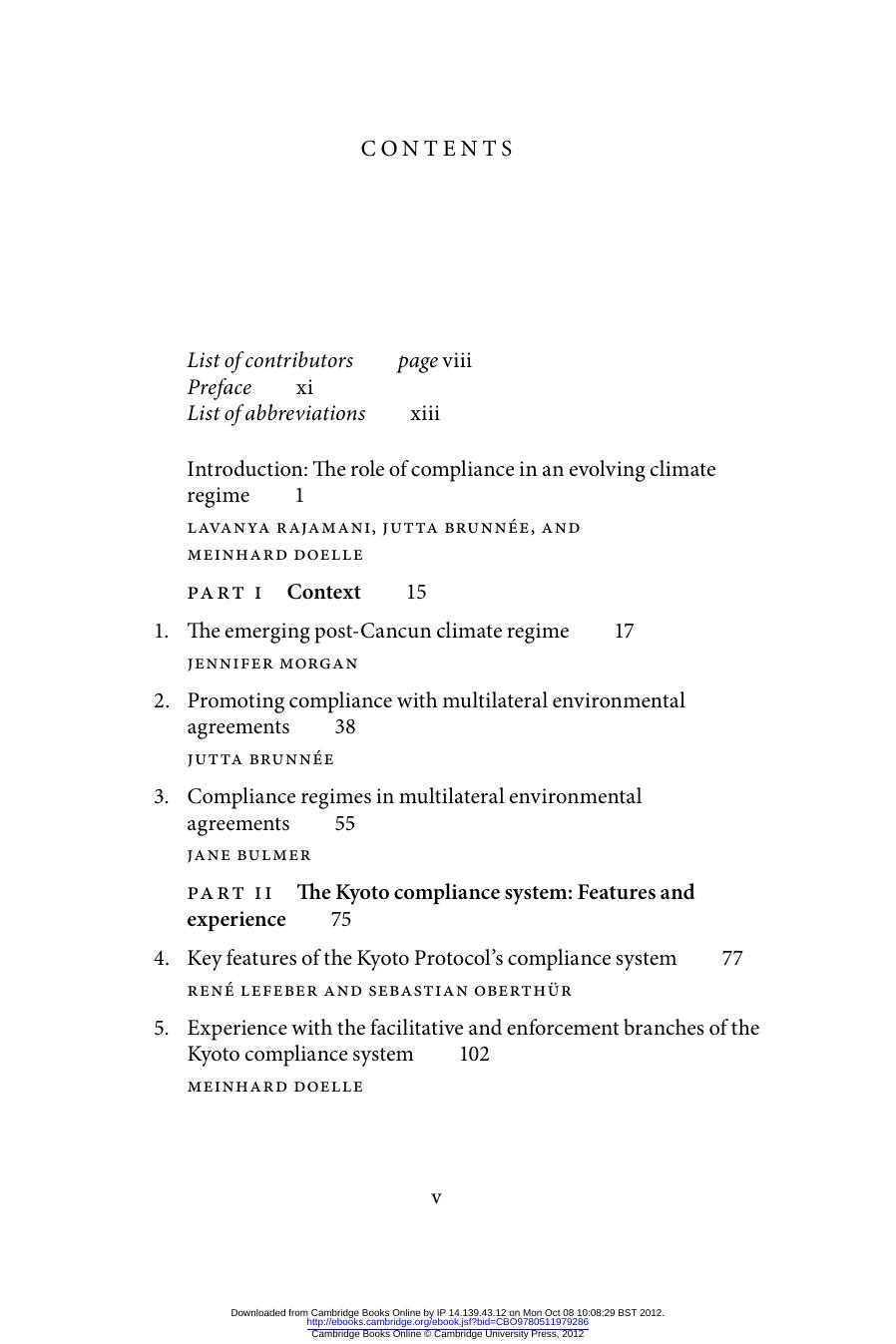Promoting Compliance in an Evolving Climate Regime by Jutta Brunnée & Meinhard Doelle & Lavanya Rajamani

Author:Jutta Brunnée & Meinhard Doelle & Lavanya Rajamani
Language: eng
Format: mobi, pdf
Tags: Law, Environmental & Natural Resources Law
ISBN: 9780511979286
Publisher: Cambridge University Press
Published: 2012-01-04T18:30:00+00:00
Cambridge Books Online
http://ebooks.cambridge.org/
Promoting Compliance in an Evolving Climate Regime
Edited by Jutta Brunnée, Meinhard Doelle, Lavanya Rajamani
Book DOI: http://dx.doi.org/10.1017/CBO9780511979286
Online ISBN: 9780511979286
Hardback ISBN: 9780521199483
Paperback ISBN: 9780521136136
Chapter
12 - Compliance and the use of trade measures pp. 262-285
Chapter DOI: http://dx.doi.org/10.1017/CBO9780511979286.017
Cambridge University Press
12
Compliance and the use of trade measures
Jacob Werksman
1. Introduction
h
e Cancun Agreements, adopted by the sixteenth Conference of the
Parties (COP) to the UN Framework Convention on Climate Change
(FCCC) were initially welcomed as restoring faith in multilateralism. 1
COP-16 is, however, more likely to be remembered as introducing a new
form of multilateralism to climate policy, by marking the end of the Kyoto
Protocol’s (KP) approach of internationally agreed, legally binding tar-
gets overseen by a global compliance mechanism.
h
e post-2012 climate regime promises, across a number of dimensions,
to be far more ‘bottom-up’ in its construction. h
e developed country tar-
gets and the developing country nationally appropriate mitigation actions
(NAMAs) that are at the core of the Cancun Agreements have been put
forward by each party unilaterally, using only minimal agreed standards.
As is described elsewhere in this volume, these undertakings, most fre-
quently characterized as ‘pledges’, are not yet internationally legally bind-
ing, and the international processes parties have agreed for measuring,
reporting, and verifying each other’s performance against these pledges
do not, as of yet, lead to any binding consequences for non-compliance.
Cancun’s more bottom-up approach has been driven, in part, by the
refusal, since the adoption of the Kyoto Protocol, of the United States
(US) to undertake any internationally legally binding greenhouse gas
(GHG) targets without i rst securing the passage of domestic legislation
necessary to achieve those targets. h
e US has also insisted that any new
1 B. Blomme, ‘HOPE in Cancun: Big Leap for Multilateralism, Small Step for the Climate’,
Greenpeace Blog , 11 December 2010, at www.greenpeace.org/canada/en/Blog/hope-in-
cancun-big-leap-for-multilateralism-s/blog/30923 ; S. Goldenberg, ‘Cancún Agreement
Rescues UN Credibility But Falls Short of Saving Planet’, Guardian.co.uk (12 December
2010), at www.guardian.co.uk/environment/2010/dec/12/cancun-agreement-rescues-
un-credibility ; and T. Roberts, ‘h
e Patient is Alive: A Turning Point for Multilateralism
at Cancun?’, Intercambio Climatico , at www.intercambioclimatico.com/en/2010/12/14/
the-patient-is-alive-a-turning-point-for-multilateralism-at-cancun .
262
Downloaded from Cambridge Books Online by IP 14.139.43.12 on Mon Oct 08 10:10:02 BST 2012.
http://dx.doi.org/10.1017/CBO9780511979286.017
Cambridge Books Online © Cambridge University Press, 2012
Compliance and the Use of Trade Measures
263
internationally legally binding agreement must include commitments by
major emerging economies (or ‘ BASIC’ countries 2 ) that are ‘comparable’
to US commitments. h
e BASIC countries support a new, legally binding
treaty, but they would like that treaty to replicate the design of the KP’s
i rst commitment period, in which only developed countries undertook
specii c, time-bound, and legally binding targets. 3
Public concern about global warming, despite the stand-of over the con-
tent and legal form of a future climate change regime, has led towards more
dramatic developments at the national, than at the international, level. In the
years since the KP was adopted, climate-change-related policies have been
developing apace in many countries – particularly in the European Union
(EU), but also in the US and BASIC countries. h
e focus of these domestic
processes has been less on the need for global collective action to combat
global warming and more on securing the long-term benei ts and compen-
sating for the near-term costs of a transition to a low-carbon economy.
h
ese
Download
Promoting Compliance in an Evolving Climate Regime by Jutta Brunnée & Meinhard Doelle & Lavanya Rajamani.pdf
This site does not store any files on its server. We only index and link to content provided by other sites. Please contact the content providers to delete copyright contents if any and email us, we'll remove relevant links or contents immediately.
Second Nature (The Shape-Shifter Series #1) by Jae(1210)
The Global Commons by Susan J. Buck(1065)
Petroleum Contracts by Peter Roberts(1035)
Infrastructure by Frischmann Brett M(986)
The Monk by Matthew Lewis(957)
Japan Travel Guide: Things I Wish I Knew Before Going To Japan (2019 EDITION) by Fukuyama Ken & Fukuyama Yuki(928)
Ever After by William Wharton(895)
Good for You, Great for Me by Lawrence Susskind(880)
War of the Whales by Joshua Horwitz(870)
Before Earth Day by Karl Boyd Brooks(865)
Biting the Hands that Feed Us by Baylen J. Linnekin(833)
Respecting Animals by David S. Favre(822)
Uncommon Ground by William Cronon(818)
Animal Law in a Nutshell by Frasch Pamela & Hessler Katherine & Waisman Sonia(803)
After Nature: A Politics for the Anthropocene by Jedediah Purdy(793)
Rangeland Systems by David D. Briske(793)
The Ethics of Space Exploration by James S.J. Schwartz & Tony Milligan(786)
Fracking the Neighborhood by Jessica Smartt Gullion(767)
Down to the Wire: Confronting Climate Collapse by David W. Orr(753)
